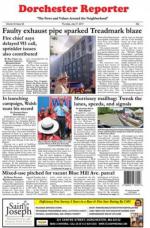May 9, 2019

Carolyn Chou, a member of Dorchester Not for Sale, addressed the audience during a May 8 meeting at DotHouse Health to discuss the PLAN: Glover’s Corner initiative. Yukun Zhang photo
About 80 people packed a DotHealth meeting room last Wednesday evening as officials from the Boston Planning & Development Agency (BPDA) shared the agency’s draft plan for Glover’s Corner. While community members reviewed the plans, members from the neighborhood organization Dorchester Not for Sale protested, demanding an extension of the planning process and “real affordability.”
The draft proposal, which grew out of a two-year process with meetings and workshops, sets up guidelines for future developments in the stretch of land along Dorchester Avenue roughly between the Savin Hill and Fields Corner T stations. The guidelines give directions for land use, road design, new housing, commercial spaces and climate resilience.
“We don’t own any property… but we can set the guidelines on how tall things can be, what’s the density, how much housing or office space is allowed here,” said Phillip Hu, a BPDA planner who led the meeting. “We can also say, ‘Hey, you need to make space for streets and parks.’”
Skyler Lam, a high school senior from Dorchester, was working assiduously with her brother putting sticky notes on pages and writing down ideas like solar panel sidewalks and free Wi-Fi. She said the re-development of the neighborhood is very personal for her. “Some of the pictures I see, I walk by them every day… I will see the impacts, I have already seen the impacts,” she said.
Dionte Bell, a Union 327 carpenter, said he found out about the Glover’s Corner planning meeting only last week, and thinks that having housing or more trees on Freeport Street would improve its bleak outlook.
In the current BPDA draft plan, a building up to 70 feet should have 13 percent of its units affordable on-site or 15 percent off-site. The rates for affordable units in buildings higher than 70 feet are 15 percent on-site and 17 percent off-site. Besides the affordable units in market-rate developments, city-owned land “offers the opportunity to accommodate hundreds of new income-restricted units,” according to a BPDA statement.
The plan includes priority areas preserving the area’s character and how density would relate to existing buildings, small-business focused job goals, and connectivity and mobility. A segment of the draft plan focuses specifically on housing stability, including recommendations on purchasing existing housing to preserve income restricted housing, highlighting neighborhood preference for up to 50 percent of housing lotteries, and reiterating moves on the city level for policies that seek to “improve resources for tenants facing displacement and expand the rights of tenants to reduce the threat of displacement.”
But for some neighbors, BPDA’s recommendations don’t address their concerns about the displacement of current residents and new job opportunities. Dorchester Not for Sale, an organization that formed in reaction to the Glover’s Corner planning effort, held a protest session during last week’s meeting. They held signs, voiced their concerns, and invited meeting attendants to join them for conversations.
“We want to see specific numbers of affordability before this moves forward,” said Carolyn Chou, a group member, said through a microphone. “We want to make sure that the jobs that are coming here are for the residents.”
Chou told the Reporter that neighbors’ feedback has not been incorporated into the plan, and that the city should make plans for the need and vision of the people instead of developers.
The group is demanding that BPDA extend the planning process for another six months. Other demands include estimates for new housing and income-restricted housing, a 65 percent rate of affordable housing, a plan for no displacement and more specifics on local businesses and jobs.
The development agency said the public process for the planning area has included 16 workshops, 10 advisory group meetings,3 deep dive sessions, monthly briefings to area civic association, nine neighborhood drop-ins, and a question campaign. The planning guidelines will require approval from the Boston Zoning Commission, which will offer additional opportunities for the public to weigh in.
Comments to the plan can be submitted online on the BPDA projects page. Another workshop will be held in early June for a review of the full plan document and discussions about next steps.
More than 30 percent of the population in the planning area is Asian, and 31 percent of the businesses on Dorchester Avenue in the planning area are Vietnamese-owned. In Wednesday’s meeting, handouts about the plan area were available in Vietnamese and Cape Verdean Creole. A timeline for the planning process was also shown in three languages.
But a Vietnamese organizer for Dorchester Not for Sale said she had to call people from the Vietnamese community to inform them about the meeting and that the room was so loud that the Vietnamese-speaking people moved outside to have their own discussions. The organizer, who didn’t want to be identified by name, said the meetings have been better at communicating to the Vietnamese community, but things “could be better.”
Thuan Tran, executive director of the Vietnamese American Civic Association who helped translate part of the meeting materials, saw the difficulties on both sides. She appreciates BPDA’s efforts to make the meetings accessible to the Vietnamese community and she also understands the demands for more affordable units.
“The housing prices in the neighborhood have already become not affordable…but the costs for developing are also high. I don’t know how that’s going to be,” Tran said.



